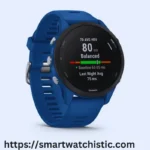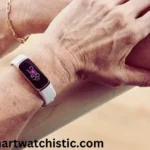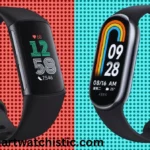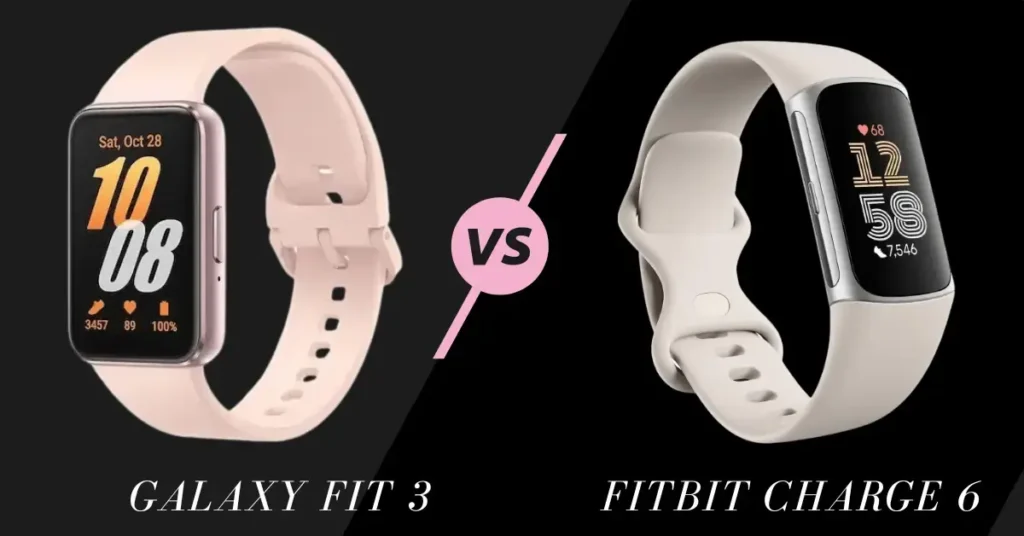
Selecting the ideal fitness tracker is similar to finding a workout partner—someone who can inspire, monitor your progress, and get you moving. With their approaches, the Fitbit Charge 6 and Samsung Galaxy Fit3 both seek to be that dependable companion. The Fitbit Charge 6, due in September 2023, is focused on general well-being, while the Galaxy Fit3, which launched in February 2024, keeps your budget in mind.
Although Samsung has not officially introduced the Galaxy Fit 3, the fitness tracker continues to make headlines all over the internet. Following the accidental listing that revealed its official photos and specifications, the device has once again been spotted. This time, it was shown in its retail packaging alongside the local price, giving clues on how much it could cost in other markets upon release.
These two competitors stand out in the world of must-reads about the best fitness trackers and health tech.
Samsung Galaxy Fit 3 vs Fitbit Charge 6 Spec
| SPECIFICATION | SAMSUNG GALAXY FIT3 | FITBIT CHARGE 6 |
| Display Type | AMOLED | AMOLED |
| Size | 42.9 x 28.8 x 9.9mm | 36.78mm x 23.1mm x 11.2mm |
| Shape | Rectangular | Rectangular |
| Screen Size | 1.6 inches | 1.04 inches |
| Resolution | 256 x 402 pixels | 260 x 170 pixels |
| Case Material | 2.5D glass (display), Aluminium (body) | Lightweight material, aerospace-grade aluminum case, Corning Gorilla Glass 3 display, anodized aluminum housing and buckle |
| Number of Physical Buttons | 1 physical button on the side | 1 physical button on the side |
| Weight | 36.8 grams | 37.6 grams |
| Sensors | Accelerometer, gyroscope, heart rate, SpO2, barometer, ambient light sensor | 3-axis accelerometer, Optical heart rate monitor, Pulse Ox, Multipurpose electrical sensors compatible with ECG app & EDA Scan app, Ambient light sensor |
| Water-Resistance | 5 ATM + IP68 | 5 ATM |
| GPS | Connected GPS | Connected GPS |
| Built-in Speaker | No | No |
| Microphone | No | No |
| Contactless Payment | No | Yes (Google Pay, Google Wallet) |
| Music Storage | No | No |
| Connection | Bluetooth 5.3 | Bluetooth, WiFi |
| Cellular Connectivity | No | No |
| Battery Type | 208 mAh Li-po | Li-po |
| Battery Life | Up to 14 days (typical usage). Supports fast charging, reaching 65% battery in just 30 minutes | Up to 7 days, or up to 5 hours with GPS |
| Operating System | FreeRTOS | FitbitOS |
| Colors | Prism Crush White, Pink, Dark Gray | Obsidian, Porcelain, Coral |
Design and Build Quality
The Galaxy Fit 3 has a 1.6-inch OLED display that’s 45% wider than its predecessor, the Galaxy Fit 2. It will also have an aluminum body and come in black, pink, and silver color options. Samsung calls its black color “gray” and its pink color “pink gold,” though. The straps can also be removed and swapped out for other colors and styles after purchase. Previously leaked images of the Fit 3 also appear to match the one shared by Samsung
The Galaxy Fit3, boasting a sleek glass display and aluminium body, exudes a sense of premium craftsmanship. This combination not only contributes to its stylish appearance but also enhances the device’s overall durability.
Fit 3 owners will be able to access health features like a heart rate monitor, fall detection, emergency SOS mode, tracking for snoring and sleep, as well as use the watch as a remote to take photos on their phone or play media, according to the company. Snore detection will only work if you have paired it with a Galaxy smartphone with an enabled microphone nearby to capture potential noise, though.
Both devices maintain simplicity in button design, featuring a single physical button on the side. This streamlined approach ensures ease of navigation and convenience for users during daily interactions with the device.
Design
| Shape | Rectangular | Rectangular |
| Colors | Black, Silver, Gold | Black, Orange, Pink |
| Body Dimension | 42.9*28.8*9.9mm | 36.7*23.1*11.2 |
| Weight | 18.5g | 37.6g |
| Case Material | Aluminum | Aluminum |
| Strap Material | Silicone | Silicone |
| Strap Size | 22MM | 22MM |
| Waterproof Rating | 5ATM | 5ATM |
Display, Colors, and Water Resistance
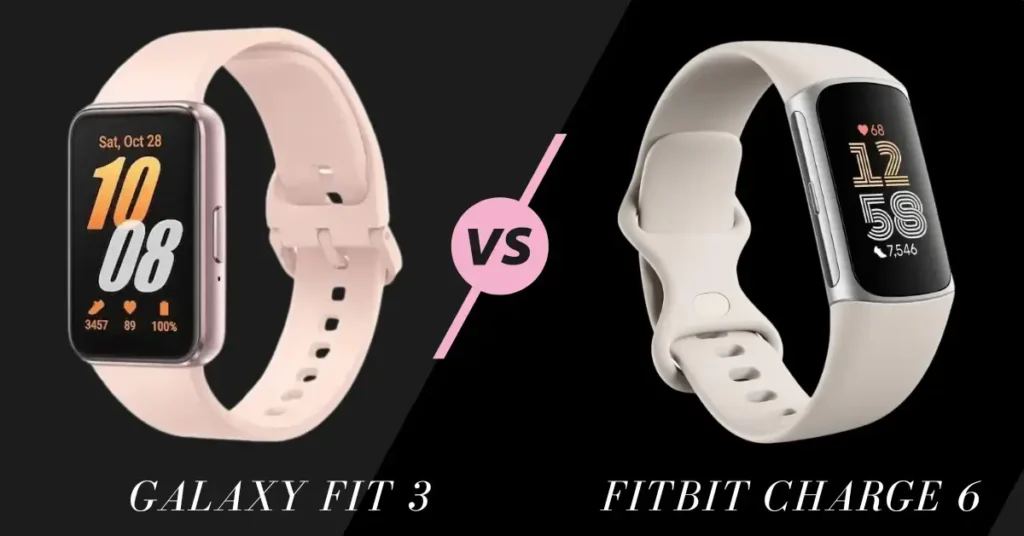
The display is a crucial element of any wearable device, impacting user experience and readability. The Samsung Galaxy Fit3 boasts a spacious 1.6-inch AMOLED display, providing a visually immersive experience.
The larger screen not only enhances the overall viewing area but also contributes to a more engaging and user-friendly interface. This is particularly advantageous for those who prioritize a vibrant and expansive display for their fitness tracking needs.
In addition, the Galaxy Fit 3 is confirmed to bring a larger AMOLED touchscreen in a rectangular aspect ratio and a dedicated physical button. The wearable also uses a quick-release button mechanism to allow easy swapping of straps. This might be inspired by the Galaxy Watch 6 (review). In addition, it is available in black, silver, and pink.
Water resistance is a crucial consideration for fitness trackers, as users often engage in activities involving water, such as swimming or showering.
Health and Wellness Features
The health and wellness features of fitness trackers have become increasingly sophisticated, catering to users who seek a holistic understanding of their physical well-being. The Samsung Galaxy Fit3, while not as health-focused as the Charge 6, offers a robust suite of fitness tracking features.
The Fit3 includes essential health monitoring features such as heart rate tracking, sleep analysis, blood oxygen level monitoring, floor counts, and activity recognition. These features are fundamental to modern fitness wearables, providing users with insights into their daily activities, sleep quality, and overall cardiovascular health.
The Fitbit Charge 6 takes a more holistic approach to wellness, incorporating additional sensors and features that extend its capabilities beyond basic fitness tracking.
The inclusion of an EDA (Electrodermal Activity) sensor allows the Charge 6 to track stress levels by measuring changes in the skin’s electrical conductivity. This feature is precious for users interested in stress management and maintaining mental well-being.
Furthermore, the Charge 6 features a dedicated skin temperature sensor, providing users with information about variations in their skin temperature. This data can offer insights into trends related to health and wellness, contributing to a more comprehensive understanding of the user’s physiological state.
The Galaxy Fit3, while not offering the same level of depth in wellness features as the Charge 6, provides a solid suite of tracking capabilities suitable for users primarily focused on fitness monitoring.
Sensors and Technology
| Acceleromete | Yes | Yes |
| Gyro | Yes | Yes |
| Heart Rate | Yes | Yes |
| Light | Yes | Yes |
| Compass | NO | NO |
| Vibration | Yes | Yes |
| Other Sensors | G-Sensor, SPO2 | G-Sensor, SPO2, barometer |
Samsung Galaxy Fit 3 vs Fitbit Charge 6 Battery Life
Battery life rumors also turned out to be correct, as the Fit 3 is able to last 13 days on a single charge, Samsung confirms.
| Battery Type | Li-Ion | Li-Ion |
| Charging Time | 2 Hours | 2 Hours |
| Battery Capacity | 208 mAh | 150 mAh |
| Battery Life | 13 Days | 7 Days |
| Standby Time | 20 Days | 14 Days |
Smartwatch-type Features
The integration of smartwatch-like features enhances the versatility of fitness trackers, offering users additional functionalities beyond health and activity tracking. The Fitbit Charge 6 seamlessly integrates with the Google ecosystem, providing users with practical and everyday utilities.
The Charge 6 supports Google Wallet for contactless payments, allowing users to make transactions directly from their wrists. This feature enhances convenience, especially for individuals who prefer the simplicity of wrist-based payments during their daily activities. Additionally, Google Maps integration provides turn-by-turn navigation, further enriching the user experience with practical navigation tools.
Beyond payment and navigation, the Charge 6 supports notifications, music control for Spotify, and quick replies to messages (for Android users). These features contribute to a more comprehensive and interconnected user experience, resembling the convenience and functionality of a smartwatch.
On the other hand, the Galaxy Fit3, while lacking NFC for contactless payments, offers a range of smartwatch capabilities. It provides notifications for calls, messages, and apps, along with music control when connected to a smartphone. The integration with the Samsung ecosystem ensures a cohesive experience for users of Samsung smartphones and services.
However, it’s essential to note that the Galaxy Fit3 may not offer the same level of integration with broader services like Google Maps or Wallet as found on the Charge 6. The choice between the two devices may depend on individual preferences regarding the ecosystems and services they are already invested in.
Samsung Galaxy Fit 3 vs Fitbit Charge 6 Price
While the Galaxy Fit3 offers a cost-effective solution for those seeking basic fitness monitoring and essential features, the Charge 6’s higher price tag may be justified for users looking for advanced health tracking, additional sensors, and a more comprehensive set of smartwatch-like features
| Price | $60.99 | $159.00 |
| Our Rating | 8.3 | 8.3 |
| Brand | samsung | fitbit |
| Category | smartwatch | smartwatch |
Conclusion: Fitbit Charge 6 and Samsung Galaxy Fit3
In conclusion, both the Samsung Galaxy Fit3 and Fitbit Charge 6 present compelling options for users seeking fitness trackers with a blend of health tracking, fitness features, and smartwatch-like conveniences. The choice between the two devices depends on individual priorities, preferences, and budget considerations.
Samsung Galaxy Fit3
- Price is a Major Factor: The anticipated lower price of the Galaxy Fit3 makes it a strong contender for users prioritizing affordability without compromising essential fitness tracking features.
- A Slightly Larger Display is a Priority: The Fit3’s larger screen may appeal to individuals seeking more viewing space and a visually immersive experience.
- Safety Features are Important: The inclusion of fall detection and SOS capabilities in the Fit3 provides added peace of mind, especially for users engaging in outdoor activities alone or with health concerns.
Fitbit Charge 6
- Comprehensive Health Tracking is Key: The Charge 6’s additional sensors, such as EDA, skin temperature readings, and built-in GPS, offer a more holistic approach to health monitoring, providing users with detailed insights.
- Built-in GPS is Essential: For users who prioritize independent tracking of outdoor exercises without relying on a smartphone, the Charge 6’s built-in GPS provides a valuable advantage.
- NFC Payments and Smartwatch Features are Appealing: The Charge 6’s integration with the Google ecosystem, supporting NFC payments and offering smartwatch-like features, makes it a more versatile choice for those seeking advanced functionalities.
Both the Samsung Galaxy Fit 3 and Fitbit Charge 6 offer excellent value, making either one a worthwhile investment. The Galaxy Fit3 caters to users who value affordability, safety features, and a larger display. In contrast, the Charge 6 is a premium option for those seeking comprehensive health tracking, independent GPS, and a richer set of smartwatch-type functions.
Ultimately, the decision comes down to personal preferences, priorities, and the specific features that align with individual needs. Regardless of the choice, both fitness trackers provide valuable tools for users looking to monitor their health, track fitness activities, and enhance their overall well-being.
